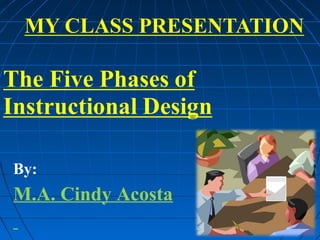
Class presentation
- 2. ANALYZE PHASE: curriculum requirements: It requires attendance and taking in consideration the content we are going to develop. limitations: Some students do not have knowledge of many of the regular and irregular verbs Resources: Laptop Copies Data show Whiteboard Markers Notebook Internet sites: how to use simple present tense http://www.perfect-english-grammar.com/present-simple-use.html http://www.englishpage.com/verbpage/simplepresent.html http://www.englishclub.com/grammar/verb-tenses_present.htm https://www.youtube.com/watch?v=nBP7FBxL_Ew
- 3. DESIGN PHASE instructional goals: To get the basic knowledge to express not only written but also orally with Simple Present. learners' needs: Students need to know the correct grammar rules to do the sentences not only positive but also negative, questions and short answers. their prior knowledge (entry level skills): Sudents should have basic knowledge of the pronouns, articles, verbs and vocabularies. Constructing assessments (as you consider goals, learners' needs, and prior knowledge). According to the evaluation Criteria: Listen to the video Participate in class Complete the internet sites
- 4. DEVELOPMENT PHASE Determine instructional strategies: I will use participation, brainstorming, feedback, active activities through internet and participation in class. select instructional media: They have to use google, youtube to see different web site that explains more about Simple Present to facilitates and support student understanding of new knowledge.
- 5. IMPLEMENT PHASE teaching/learning experience and student understanding (assessments): Through the practice students will express questions and weakness.Also, we can see the experience they have get because of the results of the evaluation of written and oral activities.
- 6. UNIVERSIDAD AUTONOMA DE CHIRIQUÍ EXTENSION UIVERSITARIA DE BOQUETE- DEPARTAMENTO DE INGLÉS DENOMINACIÓN DEL CURSO: Basic Grammar CÓDIGO DEL CURSO: Ing. PROFESORA: Cindy Acosta M. HORARIO: Miercoles 5:10- 6:45 y Viernes 6:50–8:25 Second Semester: DESCRIPTION OF THE COURSE In this course students will learn basic grammar rules that can help them to improve their skills.They will continue pulishing some new concepts so they can put in practice in their real life system. OBJECTIVES General Objective: Identify the rules of each sentence and put them in practice. Develop gramar skills so they can use it to interact correctly with theri partners. Especific Objective: Answer using the correct gramar rules we are using. Show their abilities of gramar rules assertively.
- 7. CONTENT Tell me about yourself Who want to life forever? Where do you hang out? It´s a big Mystery These are a few of my favorite things! Great ideas METHODOLOGY In each class we will discuss the information for the different topics using the textbooks, workbook and class activities. The students will participate with their own opinions about the topic. Then, we will develop grammar activities that will allow students to put in practice their learning knowledge. The students will be evaluated according to the criteria of evaluation to improve their weakness.
- 8. EVALUACIÓN Mid-term (2) 30% Homeworks, participation, attendance, 35% Final Exam 35% 100% BIBLIOGRAFY - Hemisphere student book and workbook McGraw-Hill -Touchstone Cambridge 1Workbook http://www.perfect-english-grammar.com/presen http://www.englishpage.com/verbpage/simplepresent.html http://www.englishclub.com/grammar/verb-tenses_present.htm
- 9. When Should I Use The Present Simple Tense? Okay, now you know how to make the present simple. But how do we use it? In fact, we use this tense in several different situations: (More about the difference between the present simple and the prese My Present Simple Video http://www.youtube.com/watch?v=2McNvst-g4o 1: Firstly, we use the Present Simple when something is generally true. For example, The sun rises in the east. People need food. It snows in winter. The sky isn’t green. Water boils at 100°C. Plants die without water. Two and two make four.
- 10. 2: Secondly, we need to use this tense for a situation that we think is more or less permanent (see the present continuous for a temporary situation - one which we think won't last long). Where do you live? She works in a bank. They love coffee. She has three children. I am married. I don't like mushrooms. 3: The next use is for habits or things that we do regularly. We often use adverbs of frequency in this case (also see the present continuous for new, temporary or annoying habits. Do you smoke? I play tennis every Tuesday. We often go to the cinema. She gets up at seven o'clock every day. At the weekend, we usually go to the market. How often do you study English? I don't travel very often.
- 11. 4: Four, we use the Simple Present to talk about what happens in books, plays, or films: The hero dies at the end of the film. A young woman travels through Europe, where she meets different people, and finally falls in love. In this book, an army invades Britain. The main character is very pretty and works in a bookshop. 5: We use it in the first and the zero conditional. 6: Strangely, we can use this tense to talk about the future. When you are discussing a timetable or a fixed plan, you can use this tense. Usually, the timetable is fixed by an organisation, not by us. School begins at nine tomorrow. Our train leaves at eleven. What time does the film start? The plane doesn't arrive at seven, it arrives at seven thirty. When does the class finish?
- 12. Introduction7: We also use it to talk about the future after words like ‘ when’, ‘ until’, ‘ after’, ‘ before’, ‘as soon as’ in a future sentence. I will call you when I have time. (Not ‘will have’) I won't go out until it stops raining. She'll come as soon as her babysitter arrives. I'm going to make dinner after I watch the news. I'll give you the book before you go. 8: We need to use this simple tense with some special verbs which we don't use in continuous tenses (stative verbs). Click here for more information about stative verbs. This soup tastes great. You look fabulous. I think she is very pretty. I am cold. I promise I will help you.